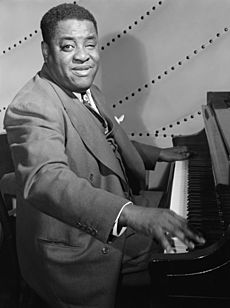Bop City facts for kids

The house formerly occupied by Bop City, now located at 1712 Fillmore Street.
|
|
| Location | 1690 Post Street San Francisco, California, United States |
|---|---|
| Coordinates | 37°47′09″N 122°25′46″W / 37.7857°N 122.4294°W |
| Owner | Jim "Jimbo" Edwards |
| Type | Nightclub |
| Genre(s) | Jazz, Bebop |
| Opened | 1949 |
| Closed | 1965 |
Bop City (also called Jimbo's Bop City) was a famous jazz club in San Francisco. It was run by John "Jimbo" Edwards from 1949 to 1965. The club was in the back room of a Victorian house at 1690 Post Street. This was in the Western Addition part of the city.
During its most popular years, Bop City was known for amazing live shows. Many famous jazz artists played there. These included Billie Holiday, Louis Armstrong, Chet Baker, and Charlie Parker. It was one of the most well-known jazz clubs of its time. Bop City helped make modern jazz popular in San Francisco.
The club closed in 1965 because jazz music became less popular. The old house was later moved to 1712 Fillmore Street in the 1970s. This happened during a time when the city was changing the neighborhood. The house is still there today. It has been named a special San Francisco Landmark.
The Story of Bop City
Bop City was one of San Francisco's best-known jazz spots in the 1950s. It was located at 1690 Post Street in the Fillmore/Western Addition area. This neighborhood used to be home to many Japanese Americans. But it became a mostly African-American area after Japanese Americans were moved away during World War II.
In the 1940s, traditional jazz was very popular in San Francisco. This was different from Los Angeles, where modern jazz styles like swing and bebop were big. But in the late 1940s, new clubs started opening. These clubs helped change the music scene in San Francisco.
Bop City started from an earlier club called Vout City. This club was run by Slim Gaillard in the same building. When Gaillard left, Charles Sullivan took over. He rented the building to John "Jimbo" Edwards. Jimbo first wanted to open a cafe called Jimbo's Waffle Shop. But musicians convinced him to add a stage in a bigger back room. This is how Bop City was born!
Famous Faces and Late-Night Fun
The San Francisco club opened in March 1949. The first concert featured the Dizzy Gillespie Orchestra and Sarah Vaughan. Bop City was famous for its late-night jam sessions and parties. The club only opened at 2:00 AM and stayed open until 6:00 AM. This was after all other places had closed.
Pony Poindexter, a musician, described the scene:
One morning, Art Tatum had a special party at Bop City. There was lots of food. After everyone had eaten, we listened to some real piano playing. Hours went by, and no one left. It was daybreak. Finally, it ended. I was tired from playing and listening. The next weekend, we had the three big trumpet players of bop style: Dizzy Gillespie, Miles Davis, and Kenny Dorham. Dexter Gordon was also there. The music went on until noon the next day. Jimbo gave them a special dinner.
Many amazing artists played at Bop City. These included Duke Ellington, Miles Davis, Count Basie, Billie Holiday, and John Coltrane. The saxophonist John Handy started his career here. He played with other great musicians.
Bop City was also where Louis Armstrong and Charlie Parker met for the only time. Armstrong came to the club after his own concert and found Parker playing. Young Clint Eastwood also visited the club. Other famous people like Joe Louis, Marilyn Monroe, and Sammy Davis Jr. were also seen there.
Writers like Jack Kerouac and artists also loved the club. A painter named Harry Everett Smith painted the walls with cool designs. He also created a light show that went along with the music. Entry was only $1, and musicians got in for free. But Jimbo Edwards always decided who could come in. He once said:
We don't allow no squares in Bop City. If you don't understand what we doin', then leave and don't come back.
The singer Mary Stallings talked about the club's atmosphere:
It's such a spiritual music, it really brings people together. And for that time, people who had any kind of unfair feelings, they don't even feel it. They'll sit next to each other and won't feel a thing. I mean, that's from the heart.
The End of an Era
In 1965, Jimbo Edwards had to close Bop City. Other famous jazz clubs like the Black Hawk also closed around that time. This was because fewer people were interested in jazz music.
In the mid-1970s, the Victorian house where Jimbo's Waffle Shop was located was moved. It went two blocks west to 1712 Fillmore Street. However, the back room where Bop City was located was torn down. From 1980 to 2014, the house was home to Marcus Books. This was the oldest African-American bookstore in the United States.
In 1998, a documentary film called The Legend of Bop City was made. It was about the club and featured Jimbo Edwards. John "Jimbo" Edwards passed away in April 2000 at age 87.
On February 13, 2014, the city of San Francisco officially named the house at 1712 Fillmore Street a San Francisco Designated Landmark. This was to honor its history as both Bop City and Marcus Books.



